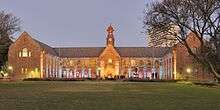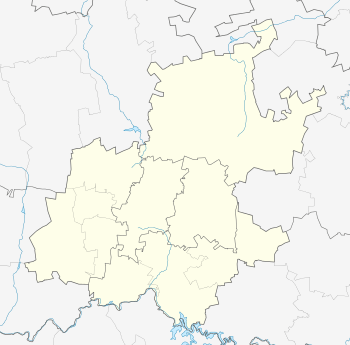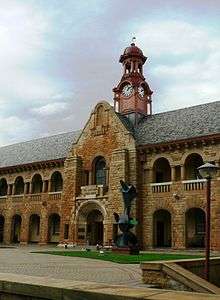Mapungubwe Collection
 The Old Arts building houses the museum | |
 Location within Gauteng | |
| Established | 2000 |
|---|---|
| Location | Pretoria, South Africa |
| Coordinates | 25°45′18″S 28°13′55″E / 25.755080°S 28.231988°E |
| Type | Archaeology museum |
| Collection size | Mapungubwe Collection |
| Public transit access | N4 and N14 national routes, cnr Lynnwood & Roper St, Loftus Versveldpark Metrorail Station, Tukkies station for the A Re Yeng rapid bus transit system. |
| Website |
www |
The Mapungubwe Collection curated by the Department of UP Arts at the University of Pretoria Museums comprises archaeological material excavated by the University of Pretoria at the Mapungubwe archaeological site since its discovery in 1933. The archaeological collection comprises ceramics, metals, trade glass beads, indigenous beads, clay figurines, and bone and ivory artefacts as well as an extensive research collection of potsherds, faunal remains and other fragmentary material. The University of Pretoria established a permanent museum in June 2000, thereby making the archaeological collection more widely available for public access and interest beyond the confines of academia.
The archaeological site of Mapungubwe
The archaeological site of Mapungubwe [pronounced: Mah-POON-goob-weh], is located on the borders of Zimbabwe and Botswana in the Limpopo Province, and is situated near the confluence of the Shashe and Limpopo Rivers in southern Africa. It is here along these major rivers that the rise of complex Iron Age societies first began at the site of Schroda, a Zhizo/Leokwe community (AD 900 - AD 1000). Thereafter, a shift in regional economic and socio-political changes gave rise to the new nearby settlement of K2 (AD 1030–AD 1220). A ruling class emerged and thus the first southern African state came into being at Mapungubwe Hill (AD 1220 - AD 1290).[1] These sites collectively form the core area of a World Heritage Site, recognised for both its natural and cultural landscape that are considered to be of outstanding universal value.
The discovery in 1932 was first attributed to the van Graan family. Mapungubwe Hill however had already been discovered in the early 1890s by an explorer named François Lotrie.[2] Local knowledge of Mapungubwe has also been recorded from oral histories, thus supporting ethnographic and historical evidence about the awareness of Mapungubwe as a sacred hill. Evidence suggests that Mapungubwe therefore cannot be regarded as belonging to any single individual, but is rather symbolically associated with various groups of people. The combination of archaeological research, historical records and oral traditions does nonetheless expand the understanding of pre-colonial societies and their settlement in and around Mapungubwe over periods of time.
The collection

The discovery of gold artefacts on Mapungubwe Hill in 1932 served as a catalyst for detailed academic research early in 1933 after the University of Pretoria had secured research rights from the government.[2] Large-scale excavations were undertaken between 1933 and 1940, until research was disrupted by the outbreak of World War II. Intermittent excavations followed in the 1950s, which were then continued by more thorough stratigraphic excavations throughout 1960s up to the late 1990s. Over decades, these excavations and scientific findings were largely held within academia and rarely reached public knowledge. The collection was assembled over 80 years of excavations by the University of Pretoria, although minor collections of Mapungubwe material are housed at several other institutions throughout South Africa. In 2003, with the declaration of Mapungubwe by UNESCO as a World Heritage Site, a suspension was placed on all excavations at Mapungubwe, a decision which is still in place as of 2016.
Only a small percentage of the Mapungubwe finds, which are curated by the Museum and the Department of Anthropology and Archaeology, are on display for the public.
Part of the collection is loaned to the Mapungubwe Interpretation Center in Mapungubwe.[3]
The collection's most famous artifacts is known as the golden rhinoceros of Mapungubwe, which is currently housed in the British Museum.
| Wikimedia Commons has media related to Mapungubwe Collection. |
See also
References
- ↑ Steenkamp, Charl. "Mapungubwe Collection – University of Pretoria". ShowMe™ - Pretoria. Retrieved 2016-10-10.
- 1 2 "Mapungubwe". South African History Online. Retrieved 2016-10-10.
- ↑ York, Geoffrey (6 September 2012). "The return of the Golden Rhino". The Globe and Mail. Retrieved 10 October 2016.
- Fleminger, David (2008). Mapungubwe Cultural Landscape. 30° South Publishers. ISBN 978-0-9584891-5-7.
- Huffman, Thomas N. (2005). Mapungubwe: Ancient African Civilisation on the Limpopo. Wits University Press. ISBN 978-1-86814-408-2.
- Meyer, A. (1996). "The Iron Age sites of Greefswald: stratigraphy and chronology of the sites and a history of investigations". Pretoria: University of Pretoria.
- The Mapungubwe Institute for Strategic Reflection (MISTRA) 2012. Mapungubwe Reconsidered: Exploring beyond the rise and decline of the Mapungubwe state,) Mapungubwe Research Report
- Tiley, Sian, ed. (2011). "Sermons in Stones, Poetry in Potsherds". Mapungubwe Remembered: Contributions to Mapungubwe by the University of Pretoria. Chris van Rensburg. ISBN 978-0-86846-109-0.
